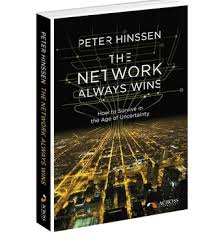VUCA
 Peter Hinssen describes today's world using the acronym VUCA. This stands for:
Peter Hinssen describes today's world using the acronym VUCA. This stands for:
- Volatility, or a lack of stability and predictability
- Uncertainty, or not knowing the right direction or what comes next
- Complexity that can no longer be handled via rational or traditional approaches
- Ambiguity, or the extent to which context is open to different interpretations.
According to traditional business models, stability, predictability, rational logic and clarity are the factors for building successful IT systems. VUCA, the way the world looks today, is a long way away from this. The question, then, is the extent to which a traditional approach and traditional systems are still relevant, and how much longer this will be the case.
VACINE
Peter Hinssen believes that the acronym VACINE is the answer to VUCA. He describes a number of characteristics that an organization needs to adopt in order to equip itself for the future. VACINE stands for:
- Velocity
- Agility
- Creativity
- Innovation
- Network
- Experimentation
Take a moment to consider how far your organization meets these prerequisites. Do you need to start looking at initiatives and processes inspired by VACINE? At present, the old models of efficiency and perseverance are probably still predominant in business – I am certainly not saying we should throw out the baby with the bathwater. Nevertheless: standing still is the same as going backwards, especially in these rapidly changing times.
People, not technology, are at the heart of agility, creativity, innovation and networks. Only those companies that understand that the people are the focus will be able to transform into connected, network-oriented organizations which are able to offer customers continuity and attract highly motivated employees.
Here we go more deeply into this topic - long read
Speed and time
What is speed? It is highly relative. E-commerce was supposed to replace traditional retail by the end of the 90s. Until a few years ago, brick-and-mortar retailers seemed to be doing OK. But with double digit increases (+15%) now being recorded, the casualties in this sector can no longer be counted on one hand. Exponential growth and decline are hard to estimate.
This is why new business initiatives need to start delivering results immediately. We can no longer afford to give ourselves a few years of breathing space. This has major consequences for IT architects:
- There is not always sufficient space to create something new.
- The architecture is created in smaller building blocks, and each block has to deliver corporate value.
- Rapid growth resulting from high consumer expectations requires attention to qualities such as scalability, reliability and maintainability.
Connected Company Principle:
A connected company platform is comprehensive. Maximize the development time spent on building things that provide value to you and your customers. Choose technology that can provide all the necessary building blocks without having to lose time on a lack of coherence and compatibility, while remaining open and utilizing standards that enable you to connect at any given time with any given peer.
I recently read somewhere that anyone who is proud of the first version of their product has probably waited too long to bring it to market. The balance between speed and guaranteeing quality is the challenge for every modern application architect.
A platform is not linear
Connected Company Principle:
Do not create projects; create a platform to support your "connected" efforts. This platform will help you to be in the vanguard of the digital transformation, and provides you with the agility to expand and make changes while you learn and grow.
It is difficult to reduce complex (chaotic) reality into simple linear models. Our biology causes us to seek simplicity by nature. However, laws of straight lines and models do not provide real-world solutions. In IT we have the “law of leaky abstraction”. Complex adaptive systems exist in our network society. Peter Hinssen claims that this complexity will only keep increasing ("entropy"). Networks are imperfect, evolving, complex and co-creative (a network without at least two winners is not useful).
A few years ago I read a book about Google's strategy. People assumed that any Google business had to be scalable or it was not the right business for Google. Google never got involved in reporting, because many people are needed to grow the business. Nowadays, it is difficult to imagine Google not being involved in news-gathering and distribution. But they are doing it because they found the way to make it non-linear and do it in way that allows for scalable networking.
Connected Company Principle:
Provide intelligence through learning and anticipating. Find a way to share your knowledge.
Agility
Does agility mean that architecture is dead? Not in the slightest. Architecture is becoming more important all the time. The more the context and legalities change, the more a solutions architect needs to be able to revise their solution. Agility is often considered to be an efficient solution. In fact, it is primarily a tool for change. Product owners and solutions architects cannot proceed on the basis of inspiration and unproven hypotheses. Data has to be the fuel that drives the product development process. Many organizations still continue to use data primarily to measure their business rather than to generate it. In times when good ideas are quick to become obsolete, that is not an ideal setup.
Companies are now facing a different type of consumer, i.e. one that has access to information and is a source of information itself. One-way thinking no longer works in our business models. Nowadays, you choose a vacation with the help of online search engines and forums with tips for travelers. Markets and opportunities can no longer be captured in "funnels", but behave like a network. What is noticeable here is that it is much harder to maintain brand reputation than it used to be. A price that is competitive today may not show up in the top 10 on comparison sites tomorrow.
Connected Company Principle:
The system of the future is a network. Manage your platform based on this network structure and involve all relevant groups and stakeholders who can provide support. A connected company is a network that co-habits with other networks.
It’s the people, stupid
Information is a stream. This has a range of effects on IT architecture:
- The data flows are manifold and imperfect.
- Real-time is the only time that is relevant
- “It’s the people, stupid.” Semantic interpretative, automatic translations are needed
- Smart.
According to Lernhout & Hauspie, interest in language technology appears to be falling, but is still gradually creeping into our day-to-day lives.
- You talk to your phone instead of using the virtual keyboard.
- You consider buying a voice-controlled media catalogue (e.g. an Amazon micro thingy)
- Google Now tells you that your flight (confirmed by email) will be boarding in three hours.
In his conclusion, Peter Hinssen argues that the future of marketing lies in personal actions rather than indirect ones. Organizations will need to focus on all available data, and learn, understand and earn trust. Clear-cut identification is critical. The power of social networks and their impact on the economy are the clearest example of this.
Connected Company Principle:
Take the approach that the design is primarily there to provide a top-class experience for your customers and employees. Be personal, because in the end it is people who determine your success.
It’s not the technology, stupid
You can no longer become a successful player in the digital economy by investing in IT alone. The way that we organize ourselves is critical. In this book, all of the organizational charts, contracts, career plans, and values such loyalty and devotion are reworked. In their place are network nodes, projects, tasks, relevance and passion.
"Command and control" structures still frequently hamper progress when dealing with initiative, innovation and experimentation. Three things form the basis for any change, including for digital business models. To set up a fluid organization, three things are essential:
- Culture becomes feeling
- Structure become acting
- Organization becomes living
'Structured' and 'fluid' are not contradictory concepts, argues Hinssen, just as architecture and agile are not contradictory.
Connected Company Principle:
Be podular to provide autonomy. Follow the example of successful start-ups: they work with small, informal teams in which employees and customers feel connected to one other. Create your own functional units that operate as autonomous enterprises within your company.
This principle implies a significant amount of change in the architect's role:
- A good grasp of the technology is required in order to be able to asses the impact and value. "The architect is an advocate".
- An architect needs to understand the ins and outs of the company (capital, processes, people, etc.) and the business (value chains and markets). "The architect is a product developer".
- They have to be able to check value assumptions in great detail. "The architect is a data and business analyst".
- Architects orchestrate the experiment and guarantee quality where and whenever this is necessary.
Connected Company Principle:
Focus on desires, not needs. Be vigilant if you are relying too much on past knowledge, and focus on desired outcomes and experience.
Conclusion
Peter Hinssen's books are quick and easy to read. They are full of neat insights and stories from the world of business. It is clear that he is experiencing the digital revolution from the front line. Whether it will have an impact on your business activities sooner rather than later is not something that can be generalized. It is, however, clear that the wave of digitalization is changing our behavior and consumption patterns in subtle ways. Companies that fail to take note of this or that fail to transform into network-oriented organizations will find themselves last in line when it comes to continuity, profitability and market share (customer perspective). They will also find it much more difficult to attract motivated employees (employee perspective).
Our advice to you is the same as our slogan: to get there, together.
 Stefan Smeets, Consultant Business&IT Alignment, stefan.smeets@realdolmen.com
Stefan Smeets, Consultant Business&IT Alignment, stefan.smeets@realdolmen.com
Would you like to learn more about how a connected company can work? Contact our expert Roel De Cuyper, Division Manager at The Connected Company, at roel.decuyper@realdolmen.com.
